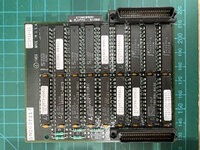It is possible that the T48 does something bad to the chip especially if it isn’t known if the part in question is actually a GAL and not a PALCE or other PAL variant.
Could be. The software allows you to select the device type and I had specifically selected GAL20v8 (I think that was the earliest guess as to what the chip could be -- now it looks more likely it's a GAL22v10). But how would a read damage a chip? I guess anything is possible? But note I did it read it 2 or 3 times without issue -- it's why I guessed the security fuse was set as all I was seeing is high bits in the dump. It was only a few days later after I tested the card again that I saw the accelerator was no longer detected, and then attempting to read the chip again gave me an error saying the chip wasn't readable.
I figure the original board that’s been troublesome had them all sanded down?
Yeah, the original board had all 18 chips sanded down and they all look basically the same.
Send them both and I’ll try to get as much as possible off the dead one and only touch the known working one when absolutely necessary.
Ok, I will consider that, if it's not too much trouble for you to take a look. I'm in the US so I'd have to take a look at shipping/customs costs to get these boards (daughtercards + mainboards for testing) to you in Europe and back. Need to figure out whether that cost is worth it for 1.) solving my curiosity and 2.) restoring the one daughtercard (I can still use the other card in non-accelerated mode).
FYI, I do have some other damage on the non-working daughterboard that I caused during experimentation putting it through all sorts of tests over the past 9 months. It's ugly but I patched them up best I could. None of that damage was causing the problems or new problems though.
I woke up this morning with an itch to do the following:
- Pull the working chip off the working board and slot it into the DIP socket I placed on the non-working board to confirm replacing that chip allows the non-working board to function properly. Just desoldering the chip, no biggie.
- Attempt to read the working chip to see if the ones on this new board don't have the security fuse set (given they were not sanded). But the issue with the other chip has totally spooked me and so I don't think I have the guts to try this.
Since there is already 1 bad board, another good strategy would be to try to read a device OTHER than the failed one on the old board. If that one is damaged and not readable, then you would still have enough parts for 1 working board. This way might be the safest.
Like I mentioned, so tempted to try and read one of the chips off the working board to see if those don't have the security bit set. That way I don't have to spend on shipping. Could reduce risk by trying this on a different chip (with the idea of harvesting that chip off the old board if I screw it up). But I probably shouldn't

too spooked.

